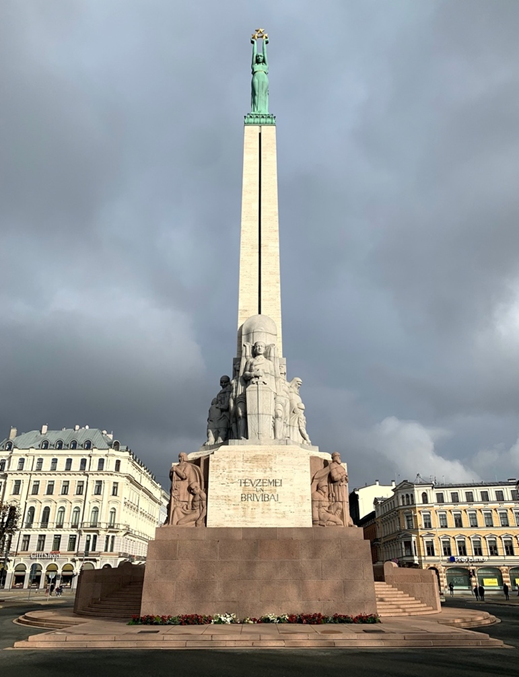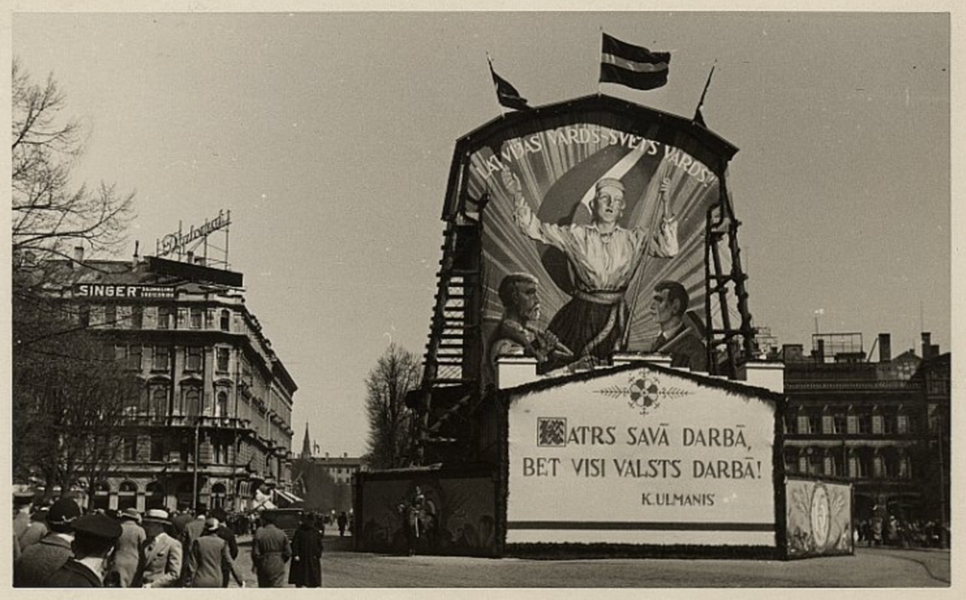The Freedom Monument (located at the head of Brīvības Boulevard in the centre of Riga) is an outstanding example of the synthesis of sculpture and architecture and the most important symbol of the independence and freedom of the Latvian state and Latvian people, built with popular donations.

The Freedom Monument
Photo: J. Dambis
The idea of an independence memorial came about in 1921. In 1922, the Latvian Cabinet of Ministers commissioned a proposal for a ‘memorial pole’. For several reasons, implementation of the idea was delayed. Project competitions were held in 1922, 1923–1924, and 1925, but without satisfactory results.

A Freedom Monument Committee was established in 1927, tasked with organising the construction of the monument. A project competition was held again in 1929–1930, with the proposal by the sculptor Kārlis Zāle (1888–1942) being awarded the top prize. In July 1931, Zāle’s design was approved with minor changes, and the cornerstone of the monument was laid on 18 November that year. The monument was unveiled on 18 November 1935.

Construction of the Freedom Monument

Opening of the Freedom Monument, Prime Minister K. Ulmanis, President A. Kviesis (opening speech), Minister of War J. Balodis in the tribune
Ernests Štālbergs (1883–1958) developed the architectural design of the monument and led its construction, while the sculptors Mārtiņš Šmalcs (1904–1984) and Nikolajs Rambaks, stonemasons Viktors Koļesņikovs, Alfrēds Rullis, Eduards Jākobsons and others participated in the production of the sculptural elements based on Zāle’s designs. The sculpture at the top of the monument was made in the workshop of the Swedish sculptor Ragnar Myrsmeden (1889–1989) in Stockholm, with the participation of the metal artists Arnolds Naiks (1908–1981) and Jānis Zibens (1909–1961).


Thanks to the work of people in the culture sector, the Freedom Monument was preserved during the Soviet occupation and even partially restored in 1980–1981. During the restoration of Latvia’s independence in the late 1980s, many anti-Soviet demonstrations took place at the monument.

Demonstration of the Baltic Way at the Freedom Monument
Restoration work of various scales was performed on the monument in 1998–2001, 2013, and 2017. In 2011, a Room of Honour was set up at the base of the monument. On 11 June 2020, the Latvian Parliament adopted the Freedom Monument and Riga Brethren Cemetery Law to ensure the preservation of the Freedom Monument and Riga Brethren Cemetery as symbols of Latvia’s struggle for national independence, national identity and national consciousness, and as places sacred to the Latvian people.

Restoration of the Freedom Monument
The monument is located in an extended open area between the bridge across the city canal and Raiņa Boulevard. Previously, this place was the location of a monument to Tsar Peter I of Russia (1912): the statue was removed during the First World War.

Freedom Boulevard, monument to Peter I
The base of the Freedom Monument is architecturally sculptural in nature, with a three-level composition consisting of a large number of human figures, made of brown and grey granite and light travertine. Above it, sits a tall travertine obelisk with a female statue of Freedom, made of forged copper, holding three golden stars in her hands held above her head.

The total height of the monument is 42 m. Its main facade overlooks the Old Town (southwest). On its other, second-stage surface, clad in travertine, are the carved words of Kārlis Skalbe: ‘To the Fatherland and Freedom’. The main facade of the monument has a gap filled with glass blocks extending across the entire height of the obelisk. It is illuminated from the inside at night. On the opposite (northeast) side of Brīvības Boulevard is a round terrace with three open staircases and arched granite steps.

The doors on the terrace lead into the Room of Honour and to the stairs inside the obelisk. On the outer walls of the terrace, there are travertine reliefs: ‘Marching Soldiers’ (north side) and ‘Song Festival March’ (east side). On the northwest side of the second level of the monument base is the travertine relief ‘1905’, and on the southeast side, ‘Fighting Bermont’s Troops on the Iron Bridge’. The corners of the second level have three-figure groups made of brown granite: ‘Labour’ (west corner), ‘Mental workers’ (north corner), ‘Guardians of the Fatherland’ (east corner), and ‘Family’ (south corner).

Fragment of the Freedom Monument
In the centre of the main facade of the third level of the base is the sculpture of Mother Latvia, made of grey granite, holding a shield and a sword in front of her, alongside figures of young people. On the northwest side is the sculpture ‘Lāčplēsis’, on the northeast side, above the terrace door, the group ‘Shackle Breakers’, which is the most powerful symbol of liberation, and on the southeast side, facing the National Opera building, the group ‘Priest and a young man’ symbolises the generational transfer of wisdom.
The sculptures are typical of Zāle’s creative style, expanded to monumental proportions, synthesising the language of form of the movements characteristic to the interwar period: Modernism, Art Deco, Classicist National Romanticism, etc.
3D model of the Statue of Liberty
The point cloud was prepared by SIA "SV Solutions"
The model was created by SIA "EXACT DWIN"
Dr.arch. Juris Dambis,
Head of National Heritage Board of Latvia
Read more about the history of the Freedom Monument in the National Encyclopedia and search in the Digital Library!
Note